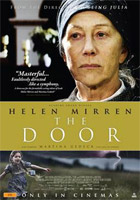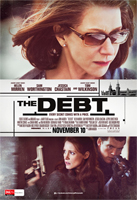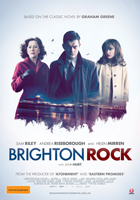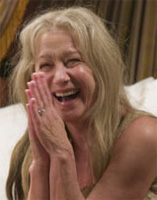Helen Mirren Woman in Gold
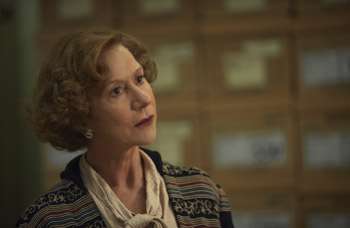
Helen Mirren Woman in Gold
Cast: Helen Mirren, Ryan Reynolds, Daniel Brühl
Director: Simon Curtis
Genre: Drama
Rated: PG
Synopsis: Woman in Gold is the remarkable true story of a woman who overcame great odds with the help of an improbably young lawyer, and righted a wrong that had stood for decades. Sixty years after fleeing Vienna during World War II, Maria Altmann (Helen Mirren), an elderly Jewish woman, begins a journey to reclaim family possessions seized by the Nazis. Among them is Gustav Klimt's famous painting, Portrait of Adele Bloch-Bauer I, a portrait of her beloved Aunt Adele, which has become a national treasure: an Austrian Mona Lisa.
Maria discovers a letter in her late sister's possessions concerning unsuccessful attempts to recover five Klimt paintings which had belonged to her family, all of which now hang in Austria's famous Belvedere Gallery. Believing she has a case for restitution and with a repressed desire for retribution stirring, she seeks advice from a young lawyer Randy Schoenberg (Ryan Reynolds), the son of fellow Austrian immigrants.
Having just started at a big law firm and with a newborn child at home, Randy is wary of burdening himself with such an unlikely extracurricular case. The lure of the famous paintings and an increasing sense of duty to his heritage overcome him, however. Inexperienced but plucky, Randy's investigation reveals there may have been a systematic cover-up, and denial on a national scale, in order to keep the paintings in Austria. Together, Maria and Randy embark upon a lengthy legal battle, taking them all the way to the heart of the Austrian establishment and the U.S. Supreme Court. The journey forces Maria to confront vivid memories of her happy family life in Vienna, reliving the pain of having everything she holds dear ripped away from her and the nerve-wracking escape that saw her emigrate to the U.S. with her husband Fritz. The arduous legal battle sees Randy gain skill and experience, which helps Maria ultimately win the paintings back, an uplifting but bittersweet victory in the light of all that was lost.
Woman in Gold is the moving and powerful real-life story of someone coming to terms with their past and seeking restitution for what was taken from her.
Woman in Gold
Release Date: May 28th, 2015
About The Production
The Story Of Maria Altmann
The youngest of five children, Maria Altmann was born in Vienna in 1916, nine years after Gustav Klimt had completed his golden masterpiece of her mother's sister, Adele. The Bauer sisters had married brothers, Ferdinand and Gustav Bloch, and together the Bloch-Bauers all shared a palatial apartment situated on one of Vienna's grandest avenues, Elisabethstrasse. Prominent figures in the city's thriving Jewish community, the Bloch-Bauers – in particular Adele and her husband Ferdinand – were wealthy patrons of the arts. Adele herself was hostess of a renowned Viennese salon that attracted prominent figures like Gustav Mahler, Arthur Schnitzler and Gustav Klimt.
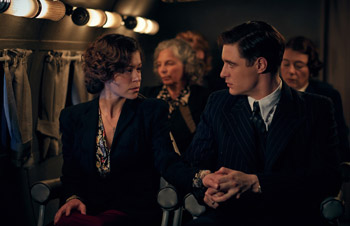 A distinguished member of Vienna's Art Nouveau school, Klimt's paintings were renowned for their eroticism, and Adele Bloch-Bauer was one of his favorite subjects. In his golden portrait, he portrays Maria's aunt like an Egyptian queen, adorned in gold and jewels. The necklace around Adele's neck in the painting would later be given to Maria as a wedding present by her uncle, Adele having died from meningitis in 1925.
A distinguished member of Vienna's Art Nouveau school, Klimt's paintings were renowned for their eroticism, and Adele Bloch-Bauer was one of his favorite subjects. In his golden portrait, he portrays Maria's aunt like an Egyptian queen, adorned in gold and jewels. The necklace around Adele's neck in the painting would later be given to Maria as a wedding present by her uncle, Adele having died from meningitis in 1925. At the age of 21, Maria married aspiring opera singer Fritz Altmann. Six weeks later, on March 13, 1938, Hitler's Germany annexed Austria into the Third Reich. The Anschluss, as it was called, was welcomed by jubilant Austrians, cheering and throwing flowers as the Nazis marched down Vienna's grand avenues. Austrian Nazis swiftly followed their patrons' lead and, amidst terrible scenes, the golden age for Vienna's Jewish community abruptly came to an end. Jewish businesses and residences were invaded and taken over, and the Bloch-Bauer's lost everything. After Fritz was arrested and briefly detained in Dachau, one of the first concentration camps, he and Maria plotted their escape from Vienna. They managed to make it first to England, and ultimately to America.
After Maria's father died, a short time later having remained in Vienna, the apartment on Elisabethstrasse was raided and its plethora of valuable contents seized. Adele's necklace, the one bequeathed to Maria, ended up in the possession of Hermann Goering's wife Emmy. In 1943, under the auspices of the Austrian Nazis, the stolen Klimt artworks were made part of an exhibition, which is when the painting of Adele – originally titled Portrait of Adele Bloch-Bauer I – was first dubbed 'Lady In Gold."
After reaching the United States, Maria and Fritz settled in California and raised four children. While her uncle's will left all his belongings to Maria and her two surviving siblings after the war, at the time the Austrian government convinced the heirs to part with the Klimts in return for releasing the lesser artworks in Ferdinand's collection to them.
In 1998, Maria solicited a family friend, Randy Schoenberg – grandson of another Viennese refugee, the composer Arnold Schoenberg – to challenge the Austrian government's claims to the Klimt painting. The provenance of the paintings was subject to conflicting opinions, due to Adele Bloch-Bauer bequeathing them to the Austrian National Gallery in an expression of wishes to her husband. She died in 1925, years before the Nazi invasion, and Ferdinand superseded her bequest with a legal will naming his nieces as heirs. When Austria rejected Maria's claim, Altmann and Schoenberg were forced to fight their way through the American court system, taking advantage of a law allowing US citizens to sue foreign governments from within the United States.
Over several years, they won at every judicial level, with Austria making a last-ditch effort to keep the paintings by appealing to the Supreme Court. When they also ruled in Altmann's favor, Austria finally agreed to settle the case via an arbitration panel comprised of three Austrian judges. The odds appeared stacked in the country's favor, but on January 17, 2006, they announced their decision: all five Klimt paintings were to be returned to Maria Altmann and her family. Later that year, the five paintings were exhibited in Maria's adopted city, Los Angeles, before going under auction and being sold to private collectors. Portrait of Adele Bloch-Bauer I was purchased for a then record $135M by cosmetics tycoon Ronald Lauder, and put on display at his Neue Galerie in New York City. Six decades after becoming victims of Nazi looting, Maria Altmann and her family had finally achieved justice. She died in 2011 at the age of 94.
About the Film
For director Simon Curtis, his introduction to the story of Maria Altmann came through watching a program made for the BBC's Imagine documentary series. Presented by his friend Alan Yentob and entitled 'Stealing Klimt," it recounted the tale of the painting, Altmann's family and her battle to reclaim the paintings which had once hung in her childhood home, and featured extensive interviews with Altmann in particular, as well as Randol Schoenberg and Hubertus Czernin, the two men most instrumental in helping her to eventually triumph.
For many reasons, Simon Curtis found himself deeply affected by Maria Altmann's story and pitched it as a potential feature to Christine Langan, Head of BBC Films. 'It spoke to so many things that interest me in the way that it bolted the Second World War and the Holocaust to contemporary America," says Simon Curtis, who had recently made his acclaimed feature directing debut with My Week With Marilyn for BBC Films and the Weinstein Company. 'To me, the painting and Maria Altmann seemed to be emblematic of the entire 20th century, both originating in Vienna in its golden age at the beginning of the century and both ending in the United States at the end of the American century."
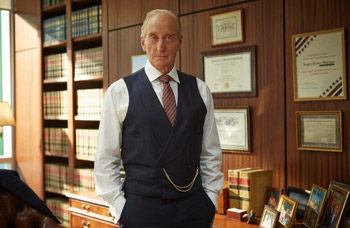 Christine Langan was won over by Simon Curtis' enthusiasm for the story and asked David M. Thompson, who founded and ran BBC Films for many years, to come on board as the project's producer. Both Christine Langan and David Thompson saw Woman In Gold as the perfect fit for Simon Curtis' sensibilities, in particular the filmmaker's adeptness at bringing real stories like the one told in My Week With Marilyn to vivid, vibrant life using large casts. 'I love submerging myself in detail and finding all the reference material I can," Simon Curtis says. 'It makes it easy when you're telling people the kind of film you want to make. With Woman In Gold, I had my photo references from the time of Maria's youth in Vienna up in the rehearsal room because I'm interested in trying to recreate what it actually seemed to have been like."
Christine Langan was won over by Simon Curtis' enthusiasm for the story and asked David M. Thompson, who founded and ran BBC Films for many years, to come on board as the project's producer. Both Christine Langan and David Thompson saw Woman In Gold as the perfect fit for Simon Curtis' sensibilities, in particular the filmmaker's adeptness at bringing real stories like the one told in My Week With Marilyn to vivid, vibrant life using large casts. 'I love submerging myself in detail and finding all the reference material I can," Simon Curtis says. 'It makes it easy when you're telling people the kind of film you want to make. With Woman In Gold, I had my photo references from the time of Maria's youth in Vienna up in the rehearsal room because I'm interested in trying to recreate what it actually seemed to have been like." To craft the screenplay, the team recruited award-winning playwright Alexi Kaye Campbell, whose debut play, 'The Pride," had been produced for the Royal Court Theatre. Woman In Gold would be his inaugural foray into writing for the big screen, but Simon Curtis and David Thompson were impressed by his smart, economical style and facility for juggling narrative strands in different time periods, as would be required for Woman In Gold. 'He has a great economy with characters and writes very sharp dialogue," observes David Thompson. 'We felt he would be able to take a difficult story like this and make it coherent and compulsive, which is exactly what he's done."
Alexi Kaye Campbell was immediately grabbed by the story, in particular its historical aspects and the juxtaposition it presented between the new world of Los Angeles and the old world of Vienna, as well as the two incredible characters at its heart. From the start, Simon Curtis, Christine Langan and David Thompson all agreed that they wanted to tell Maria and Randy's story in the contemporary world. They felt that it was equally crucial though to depict Maria's life in Vienna leading up to the Anschluss, as well as the Nazi's theft of her family's possessions and her escape to America.
While some directors might have settled for actors speaking accented English in the sequences set in pre-war Vienna, Simon Curtis was adamant that German be spoken in the historical flashbacks. 'The film is about identity and asks the question, -Are you where you're from, or where you are?'" notes the director. 'There's a scene toward the end where Maria's father, in his heart wrenching final farewell to his daughter, says, -And now I speak in English, the language of your future', which for me is a critical moment in the film. So I was lucky that everyone supported me in that."
Alexi Kaye Campbell's mission was to make the story intellectually coherent and emotionally involving, while not allowing the intricate procedural slog of Altmann's restitution case to overwhelm the film's emotional heartbeat. While Maria Altmann passed away in 2011, Schoenberg was alive, well and present throughout the development phase, keenly reading each draft of the script. Alexi Kaye Campbell recalls travelling to California to meet Schoenberg in person to discuss the case's complex legalities: 'I remember saying to him, -Randy, you've got to talk to me as if I'm a six year old boy, and maybe not the brightest six year old boy. Just talk me very slowly through the story.' It was very useful."
As well as Altmann's case and Viennese past, Woman In Gold also chronicles another crucial journey: Schoenberg as an upstart but struggling lawyer who grows in stature and confidence as he pursues Maria's case, eventually arguing its merits in front of the US Supreme Court. For storytelling purposes, the Randy Schoenberg of Woman In Gold isn't very connected to his Austrian heritage at the start but gains a powerful connection to the Jewish contribution to Viennese history as the story progresses. 'The two of them going back to Vienna allowed us to make the story very human," says Alexi Kaye Campbell. 'For Maria, it triggers everything inside her memory and her emotions."
Everyone involved in the production feels a sense of sadness that they never had the opportunity to meet Maria Altmann. Alexi Kaye Campbell relied on written documentation, first-hand accounts and the several interviews she conducted, uncovering a wellspring of rich detail that revealed a fascinating life. Maria's escape from Vienna, and the escape stories of her other family members, would be worthy of a film in their own right. 'There's an extraordinary story about Maria's brother getting out of Vienna because he once saved Hitler's nephew following a skiing accident, carrying him down the mountain with a broken leg," Alexi Kaye Campbell shares. 'Two years later, the nephew called him into Nazi headquarters and gave him papers to leave."
'It was a tremendously complex story to tell and I give full credit to Alexi for making it intelligent and intelligible," says Simon Curtis. Through his directing work with the BBC on David Copperfield (1999) and Cranford and his own feature debut My Week With Marilyn, Curtis has proved himself adept at getting the most out of large ensemble casts. While Woman In Gold is driven by two major star performances, the film contains 75 speaking roles across two languages. 'What you want from any director is a real sense of emotional commitment and a profound belief in telling this particular story," says Helen Mirren. 'I felt that with Simon Curtis. Coming from an Eastern European Jewish background, he obviously feels it in a way that somebody without that background could never feel it."
In David Thompson's opinion, he has never taken a script to market with as much heat attached to it as Woman In Gold had. Several companies entered the bidding fray, but David Thompson and Christine Langan chose to partner on the film with the Weinstein Company, in part for their long-standing reputation for being able to market films with indie sensibilities. 'Harvey had a personal passion for the story, having himself lost members of his family in the Holocaust," says David Thompson. 'While this isn't just about the Holocaust, it is a story of people seeking emotional healing from a terrible loss. It's about families and the importance of personal objects passed on within families; it's about justice; and it's about people finding an emotional connection with their past."
With Woman In Gold shooting in three countries and three time periods, Kris Thykier came on board as a producer in pre-production to help facilitate the many challenges. One of Harvey Weinstein's many key suggestions was to hire cinematographer Ross Emery, who had served the same role on his company's young adult drama The Giver. 'He's amongst the best DP's I've ever worked with," says Kris Thykier. 'The producer in me loves his technical proficiency, ability to work quickly and capably with a multi-camera set-up. But he was also intellectually engaged in the material, which made him a perfect collaborator for Simon." Curtis and Emery opted to use de-saturated visuals for the historical past, while the contemporary scenes are shot with the vivid vibrancy of modern American cinema. Woman In Gold's original score is a collaboration between Martin Phipps and Oscar winner Hans Zimmer.
Maria & Randy, Helen & Ryan
To portray the indomitable, headstrong and feisty Maria Altmann, Helen Mirren was Simon Curtis' first and only choice. 'Although I knew Helen Mirren, I'd never directed her," he says. 'So it was a thrill when she shared my enthusiasm for the script. She's perfect for the role because she's intelligent and very much her own woman. She doesn't suffer fools. She's of Russian descent and credible as someone from a Jewish milieu. She has both the wit and the anger of the character. We were very lucky to get her." 'Helen Mirren is just a consummate actress who can turn her hand to anything," adds David Thompson. 'She's subtle and delicate; she's also funny and irreverent. She's got all the right characteristics for Maria, including a sense of iconoclasm."
With Helen Mirren on board as Maria, it was Harvey Weinstein who first suggested Ryan Reynolds for the role of Randy Schoenberg. The odd-couple dimension to Woman In Gold's central relationship made everyone realize that Weinstein's suggestion was an inspired one, with Ryan Reynolds' natural wit and charm delivering an audience-friendly boost to the character.
'Ryan Reynold's got the intellect, the wit, the lightness of touch and the depth, all of which were very important for this," says David Thompson. 'He's a great choice and he immersed himself very powerfully into the character."
'Harvey called me and said, -Hey Ryan Reynolds, it's your lucky day,'" recalls the actor. 'He was right. It's a tremendous story that I had a passing knowledge of, only because I had seen the painting at a Klimt exhibition when I was a young kid backpacking through Europe. The story is fascinating, and the chance to spend a few months with the great Helen Mirren was a privilege."
For Helen Mirren, Altmann's story was a new discovery. 'Stories like this that come out of real life have extra piquancy and emotional content because you know that it was true," she remarks. 'It's that classic story of the weak versus the strong and when the weak win out over the strong, that's always a meaningful human story. I think most of us identify with that."
To prepare for the role of a Mittel-European grande dame who spent the majority of her years on American soil, the Oscar and BAFTA-winning actress initially turned to a doctor friend in Los Angeles who knew Altmann's story and said Maria was exactly like his own mother. He interviewed his mother about her life on camera, offering Helen Mirren a window into the well-educated Jewish- Viennese heritage she would be bringing to life on screen. 'She had a similar trajectory to Maria and she still had a very strong accent," notes the actress. 'It was very useful to me."
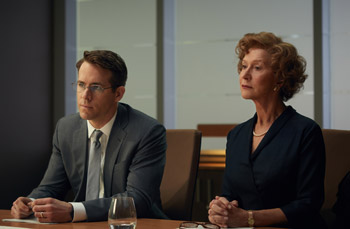
Helen Mirren also watched Altmann's deposition and read as much as she could about her and the history of the time, particularly in regard to the annihilation of Europe's Jewish population. 'The world of the movie is a much lighter world but its roots are in that darker place," Helen Mirren says. 'The more I found out about Maria, the more I loved her.
She had a wonderful sense of humor, a wonderful edginess about her, an incredible elegance and laid-back power. She seemed very powerful to me but in an understated way."
Helen Mirren was also keen to convey the deep reservoir of anger she glimpsed in Altmann, for a family destroyed, a way of life obliterated. 'That generation of people, they had to overcome their anger, they couldn't hold onto it because it was counterproductive. They were so brave because they came from absolutely nothing to a new country and made a complete life for themselves," says Helen Mirren. 'I know this a little bit from my father, who was the son of an immigrant. He was born in Russia, from a wealthy background, and you just had to forget all of that because it was gone and it was never coming back. Maria had witnessed it as a young woman so I think there was a profound anger in her although she would never express it. But you could see it in her eyes."
For Ryan Reynolds' part, he was drawn to the love story he saw in Schoenberg and Altmann's relationship and was determined to pull it off the page. 'It's not a love story that culminates in a third-act kiss," he adds, 'but it's a quiet and fierce love between them that develops over the story. They're an unlikely duo and they butt heads a lot because they both have a tremendous amount of passion for what it is they're trying to achieve – to me, it felt like a love story. That was the thing that I was really trying to cultivate in the day-to-day shooting of the movie."
Woman In Gold's two stars established an instantly playful rapport, which continued on screen and off and allowed them to build the deeply felt bond that grows between Randy and Maria. 'It's a film about relationships," says Kris Thykier. 'It's about the young Maria and her husband; about the older Maria and Randy; about Maria and her aunt Adele; about Adele and Gustav Klimt. All of those relationships are what makes the story work, and the one between Maria and Randy – between Helen and Ryan – was absolutely fantastic from day one."
'I defy anyone not to have fun with Ryan Reynolds," Helen Mirren says. 'He is such a charmer and his own natural wit was invaluable for Randy who himself is a lovely, funny, charming person."
'We had such a ball together," says Ryan Reynolds, echoing his co-star's sentiments. 'I love that woman. We were vile with one another, trying to make each other laugh and crack up during takes. Helen Mirren is one of a kind – she's hot, funny, cute and smart. It's a rare combination. I believe she's the first Dame I've ever worked with although like any great Dame, she never brings it up. I'm pretty sure I should be arrested and sent to the Tower for some of the things I've said to Dame Helen Mirren."
Although Ryan Reynolds and Robert Schoenberg eventually met during the Woman In Gold shoot, the actor avoided doing so early on, keen to avoid performing a facsimile of the real man. 'I wanted to invent my own version of Randy," he says. 'We don't look anything alike, we don't sound anything alike, so I didn't want to trap myself. When I did finally meet him, we hit it off like gangbusters." Ryan Reynolds was particularly taken with his 1998 wardrobe – 'a unique time in fashion history," he notes drily. 'I think I had a thousand pleats going on in my trousers" – and praises Robert Schoenberg for instigating mirth in the cast and crew when he turned up one day in similar attire, having dragged an old suit out of his wardrobe.
While Woman In Gold chronicles a tragic chapter in Austria's history and exists in the shadow of World War II's most appalling atrocities, both Helen Mirren and Ryan Reynolds felt it was crucial to inject moments of levity and humor into their relationship. 'Simon Curtis was excited about that too," Ryan Reynolds adds, 'and a lot of it we found on the day because Helen is so nimble as an actor. She has a lot of gears to play with and both Simon Curtis and I found that amazing to watch."
Simon Curtis returns Ryan Reynolds' praise, complimenting the balance he struck between humor and seriousness. 'Ryan Reynolds brings the audience in by being a character who's unaware of the resonance of his own family background," says Woman In Gold's director. 'He's a bit gauche at the beginning but we see him mature as he grows in understanding. The real Randy was much more expert about all things Vienna but it's a better dramatic journey to have somebody who goes from ignorance to expertise, and Ryan Reynolds played it with intelligence and a twinkle in his eye. When he is moved by events, it's all the more moving for the audience."
Woman In Gold: Other Key Cast
Portraying another Austrian who was instrumental in helping Altmann win her case is celebrated German actor Daniel Brühl, who takes the role of campaigning journalist Hubertus Czernin. A thorn in the side of Austria's establishment, Czernin rose to attention as the investigative journalist who uncovered the secret Nazi past of former Austrian president Kurt Waldheim. His dogged research on Altmann and Robert Schoenberg's behalf helped them overcome several legal obstacles, as well as uncovering key evidence which allowed them to eventually triumph in the court of arbitration.
As a fan of Klimt's art who had seen Portrait of Adele Bloch-Bauer I hanging in the Belvedere Museum during his youth, Daniel Brühl was intrigued by the film and its subject matter. 'The impact of Klimt's art is huge and culturally, for the Austrians, this painting was their Mona Lisa," says Daniel Brühl, who has followed other restitution cases involving art pilfered by the Nazis. 'The idea that a painting can be stolen twice – first by the Nazis and then by governments to hang in their museums – is terrible. This painting and Klimt's work is so beautifully iconic and unique in the world of art. Even for us, the neighboring Germans, it was of huge significance."
Furthermore, the questions raised by the Nazi persecution of Europe's Jewish population have huge personal significance to Daniel Brühl. 'Having lived almost my entire life in Germany, it's always been a very interesting and important question: how could this happen in our country? How much did people know? What happened exactly?" he ponders. 'My generation is still dealing with that guilt, and that's why I had so much empathy with my character. He's a guy who wants to do something and investigate the past."
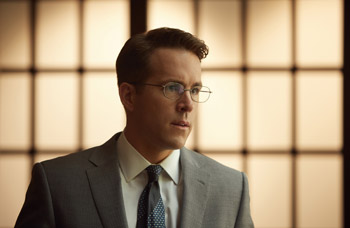 Like everyone else, Daniel Brühl was thrilled at the opportunity of working with Helen Mirren. 'She's a living legend but she makes you feel comfortable in a second," he says. 'She's very easy to work with, and to watch Ryan Reynolds and Helen Mirren adding in these funny moments was so much fun. It was a cheerful, fearless and harmonious atmosphere on set, which was also due to Simon Curtis. He treats everybody with respect and was very precise in what he wanted."
Like everyone else, Daniel Brühl was thrilled at the opportunity of working with Helen Mirren. 'She's a living legend but she makes you feel comfortable in a second," he says. 'She's very easy to work with, and to watch Ryan Reynolds and Helen Mirren adding in these funny moments was so much fun. It was a cheerful, fearless and harmonious atmosphere on set, which was also due to Simon Curtis. He treats everybody with respect and was very precise in what he wanted." At Daniel Brühl's suggestion, the production hired Austrian actress Susi Stach to serve as the dialect coach. Daniel Brühl had worked with Susi Stach on Ron Howard's RUSH to perfect the Austrian accent he needed for his acclaimed performance as Formula 1 champion Niki Lauda. Helen Mirren found Susi Stach particularly helpful in perfecting the pronounced Viennese lilt that Altmann kept throughout her life.
One of the principal difficulties Simon Curtis faced was finding the right actress to portray the young Maria Altmann. 'Including Daniel, Moritz Bleibtreu (who plays Klimt), and Antje Traue (who plays Adele Bloch-Bauer), we have five or six of the greatest German actors around who bring a tremendous amount to the film," Simon Curtis remarks. 'But to find someone who could be credible as the young Helen Mirren and also speak German was challenging. So when we met Tatiana Maslany, it was like a gift from God."
While not a native German speaker, the Canadian actress, star of the science-fiction TV series Orphan Black, was raised by a German mother and German-Ukrainian father and also studied the language at university. 'I heard German around my house when I was a kid so it was a nice way to go back to it, in the totally different way of expressing myself through a character," says Tatiana Maslany. 'I wasn't super-fluent coming into Woman In Gold so it was a challenge, but one I loved."
Kris Thykier, who also produced The Debt, compares Tatiana Maslany's casting in Woman In Gold to hiring the then-unknown Jessica Chastain to portray Helen Mirren's younger self in the spy thriller. The actress was thrilled at the prospect of portraying the young Maria Altmann in the flashback sequences to her younger days. 'Helen Mirren's legacy of work is amazing and I've always looked up to her and admired her singularity in terms of her elegance and sexuality and presence on screen. It's so powerful," says Tatiana Maslany. 'To in some way be able to emulate that, or work towards finding that in myself, was exciting."
Sharing the screen with Maslany as Maria's husband Fritz is Max Irons, another suggestion of Harvey Weinstein's. Not knowing a word of German, the British actor was at first daunted by the proposal but plunged headfirst into the intensive dialect work required. 'It was a bit intimidating when we came to shoot it because you're just not sure if you're doing it right," Irons says. 'Tatiana Maslany was a joy to work with but she wasn't giving me many line readings because I think she was worried she might piss me off. It was strange being the only bugger who couldn't speak German." Tatiana Maslany was struck by the fact that Maria and Fritz viewed their marriage on equal terms, something unusual for the era. 'At that time, women weren't necessarily equals to the men they were married to," she says. 'And Maria is the instigator of a lot of change in her family. She has to make big choices and big decisions. Leaving her family is hard but there is strength in that choice, in choosing to survive." It's a choice Maslany fully empathizes with: 'In our own small way, we all do that when we leave home. I moved away from my family in Regina, Saskatchewan, to pursue my career in Toronto. Cutting those familial ties comes with guilt and sadness."
One of the only cast members to have viewed Klimt's Portrait of Adele Bloch-Bauer I in its new home at the Neue Galerie was Irons. He was blown away by the replica created for the production. 'It was truly spectacular," he says. 'I have no idea where it ended up."
With Woman In Gold shedding light on Robert Schoenberg's home life as he struggles to convince his somewhat skeptical wife Pam that pursuing Altmann's case on a no-win, no-fee basis won't be the ruin of them, casting an actress to make these domestic scenes land with impact was crucial. The producers settled on Katie Holmes as the perfect choice. 'We aimed high and were very lucky to get Katie Holmes," notes Kris Thykier. Katie Holmes was thrilled to be invited to join the production and enjoyed her time collaborating with Simon Curtis, Ryan Reynolds and Helen Mirren. 'I was so moved by this story of triumph," says the actress. 'The characters are as rich and real as the intensity of the storyline. It was a very rewarding creative experience."
Rounding out Woman In Gold's phenomenal cast are Moritz Bleibtreu as Klimt; Antje Traue as Adele Bloch-Bauer; Henry Goodman and Allan Corduner as Maria's uncle and father, Ferdinand and Gustav Bloch-Bauer (British actors of German heritage who are both fluent in the tongue); Frances Fisher as Randy's mother; Charles Dance as his law-firm boss; Elizabeth McGovern as a California judge whose early verdict changed the course of the case; and Jonathan Pryce as Chief Justice William Rehnquist.
'They got incredible actors to come in and play these smaller characters," says Ryan Reynolds. 'You need somebody who can be the star of their own film to make these smaller roles impactful, and Simon Curtis's wife Elizabeth playing a judge was a beautiful touch."
London, Los Angeles, Vienna
Principal photography for Woman In Gold began on May 23, 2014, and took eight weeks to complete, with the production splitting its time between three cities. First up was London, where the cast and crew were situated for the first month of shooting. Although the UK capital does not feature in the story, London's architecture stood in for many of the story's grand interiors. Locations included Goldsmith's Hall in the City of London and Wandsworth Town Hall, deployed, respectively, for the final arbitration hearing in Vienna and the Austrian Ministry of Culture. The interior of Schoenberg's
LA law offices were in Hemel Hempstead, while his family home, Altmann's LA bungalow and the Bloch-Bauer's opulent apartment in 1938 Vienna were constructed at Twickenham Studios.
'I've shot a number of films in London before and it's always a great experience," says Ryan Reynolds, who also took a motorcycle trip around the Austrian Alps with his brother after the film wrapped. 'I love shooting in far-off places. I love taking my family with me and getting an apartment and immersing myself in those places. It's one of the great privileges you have as an actor."
The production spent five days at the end to capture the Los Angeles exteriors throughout the film but concentrated in the opening stretch, which features Altmann burying her sister and her early meetings with Schoenberg. But as an intimate tale of a Jewish refugee's quest to reclaim her family's heritage, the opportunity to spend a substantial chunk of the shoot in Vienna was immense, and both the modern-day and historical sequences filmed in the city are hugely potent. For the 1938 scenes, Curtis even recreates the Anschluss, when Wehrmacht troops marched into Vienna to complete the Third Reich's annexation of its German-speaking neighbor. As a Jewish family, the Bloch-Bauers knew Nazi occupation placed them in grave danger and Maria's subsequent efforts to escape Austria with Fritz, as well as the plundering of her family's valuable art collection, are depicted with startling alacrity.
The resonance of the entire story meant that, for Simon Curtis and everyone involved, shooting in Vienna held special meaning. 'The Vienna shoot was without doubt the most wonderful, most emotional working experience I've ever had," he states. 'We were recreating the end of the Jewish community in Vienna. It was very powerful." His extensive photographic research allowed him to recreate the Nazi procession through Vienna and their jubilant reception by the Austrian crowds. The production secured permission to hang the notorious red swastika banners from Vienna's Town Hall, and the meticulous and striking reenactment made a powerful impression on Woman In Gold's cast. 'They dressed entire avenues with the swastika banners and had processions of Nazis marching down the street – it was incredible," marvels Irons. 'Some of the extras would have been alive then and seen this first hand. Getting my head around being Jewish at that time in that place and how terrifying that would have been was a big thing."
ForSimon Curtis, the scenes depicting the Bloch-Bauer's Viennese apartment represent the heart of the film and he was keen that every moment resonated. Unfortunately the building where the Bloch-Bauers lived was being renovated at the time and was concealed under scaffolding, but the locations team found a similar building nearby to double for its elegant exterior. For the interior, they used Vienna's Palais Ausperg, a glorious beau monde residence of grand salons and the production designers covered the walls in recreations of the incredible art owned by the Bloch-Bauers. When the Nazis enter to appropriate the Bloch-Bauers' treasures, including the painting of Adele, one officer holds up a silver goblet for inspection. That goblet belonged to Curtis' own Polish great-grandfather.
'Maria's wedding was, in actual fact, the last Jewish social event before the Nazis arrived," he observes. 'I wanted Maria and Fritz's wedding dance – which is the Mezinke, the traditional Jewish dance on the marriage of the youngest child – to be like the end of an era."
While Austria has been criticized for denying its own culpability in allowing Hitler's Germany to absorb them into the Third Reich, many in the country have been forthright about the need to confront the past. Curtis and the producers praise the city's warm reception and the general feeling among Viennese that Maria's battle – which had thrown a harsh spotlight on Austria's support for the Nazis – needed to be told. 'It's a complicated thing because we were recreating a complex moment in Vienna's cultural history: the debate about whether the paintings should go back to the family or stay in the museum," says Curtis. 'And on top of that, we were recreating the biggest trauma in the country's history. We were always aware of that, but the people of Vienna were extremely hospitable and very supportive."
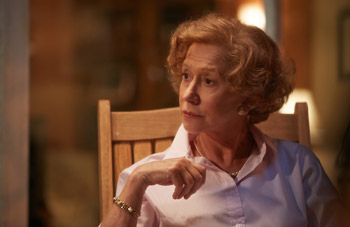 'To walk on those streets where Maria had walked and where Hitler had been welcomed with such open arms was incredibly powerful," Helen Mirren says. 'Now, it's a beautiful tourist town, wonderful to visit, with incredible museums and art everywhere. But it's very little changed from when Maria lived there because it wasn't really damaged in the Second World War. And those streets perpetrated such a terrible injustice against a whole class and section of that society. Within two weeks of Hitler's invasion, there were moves against the Jewish population." The actress, however, is also quick to point how warmly she was received in today's Vienna. She was even presented with the Freedom of the City by the mayor, a small gold replica of the statue of a soldier that sits atop the town hall.
'To walk on those streets where Maria had walked and where Hitler had been welcomed with such open arms was incredibly powerful," Helen Mirren says. 'Now, it's a beautiful tourist town, wonderful to visit, with incredible museums and art everywhere. But it's very little changed from when Maria lived there because it wasn't really damaged in the Second World War. And those streets perpetrated such a terrible injustice against a whole class and section of that society. Within two weeks of Hitler's invasion, there were moves against the Jewish population." The actress, however, is also quick to point how warmly she was received in today's Vienna. She was even presented with the Freedom of the City by the mayor, a small gold replica of the statue of a soldier that sits atop the town hall. 'I don't think they were really giving it to me. They were giving it to Maria Altmann," says Helen Mirren. 'The mayor said to me that, above all, Maria's efforts to reclaim the paintings had made the city of Vienna face up to the past. In that sense, she was an incredibly important person in the city's history."
Maria's Legacy
In its heartfelt, heartwarming and heartbreaking recounting of events, Woman In Gold conveys the true meaning of restitution for Maria Altmann: an attempt to honor her family and put the fractured jigsaw of her life back together by bringing her aunt Adele back into her possession, figuratively and spiritually.
While a bitter divide existed amongst Austrians about whether to relinquish a masterpiece they viewed as their nation's cultural treasure, most accepted that right was done when the painting was restored to Maria Altmann. 'I can understand the bond that a people or a nation can have with certain pieces of art, especially when it's as iconic and unique as Woman In Gold," Daniel Brühl remarks. 'But a lot of Austrians were in favor of giving it back because they felt it was a shame to be the illegitimate owner of something that was stolen from a family. The right thing was done."
Altmann and her family subsequently sold the five Klimt paintings, with cosmetics magnate Ronald Lauder purchasing the portrait of Adele for a then-record sum of $135M. Maria's proviso was that it should always be on public display and it hangs today in Lauder's Neue Galerie in New York City. 'I don't think the value of the painting is remotely relevant," says Helen Mirren. 'Now the money is where it should be, where it was supposed to be in the first place. These artworks were stolen in terrible circumstances and then it was covered over by years of bureaucracy. You can't turn your back on that."
'This story really strikes a chord with people because of what Maria achieved, what they both achieved," says David Thompson. 'It's a story that touches anybody who's experience any kind of loss. For them, it wasn't about possession. The possession was a symbol of something: the restoring of an emotional loss and of correcting an injustice."
Maria Altmann passed away in 2011, at the age of 94. Since winning the case, Robert Schoenberg has become an enthusiastic advocate for art restitution and set up a company dedicated to the fulfillment of those goals. He also used part of his own proceeds from the sale of Klimt's painting to help fund a new wing for the Holocaust Museum in Los Angeles, striving to keep essential memories alive for future generations. That is a connection Reynolds hopes Woman In Gold will also make. 'I really hope this film connects with a younger generation that, in the film, Randy represents," says Ryan Reynolds. 'It's an amazing story of redemption and justice, and justice done right. I think it's important for a younger audience to see it, and for an older audience to remind themselves."
Helen Mirren sits in wholehearted agreement: 'As Maria says in the film, -People forget.' And people do forget. A story like Maria's is so important to tell. And that's the great thing about film: it can preserve a story."
Woman in Gold
Release Date: May 28th, 2015
Have You Seen This?
MORE
- Mission: Impossible Fallout
- Glenn Close The Wife
- Allison Chhorn Stanley's Mouth Interview
- Benicio Del Toro Sicario: Day of the Soldado
- Dame Judi Dench Tea With The Dames
- Sandra Bullock Ocean's 8
- Chris Pratt Jurassic World: Fallen Kingdom
- Claudia Sangiorgi Dalimore and Michelle Grace...
- Rachel McAdams Disobedience Interview
- Sebastián Lelio and Alessandro Nivola...
- Perri Cummings Trench Interview


